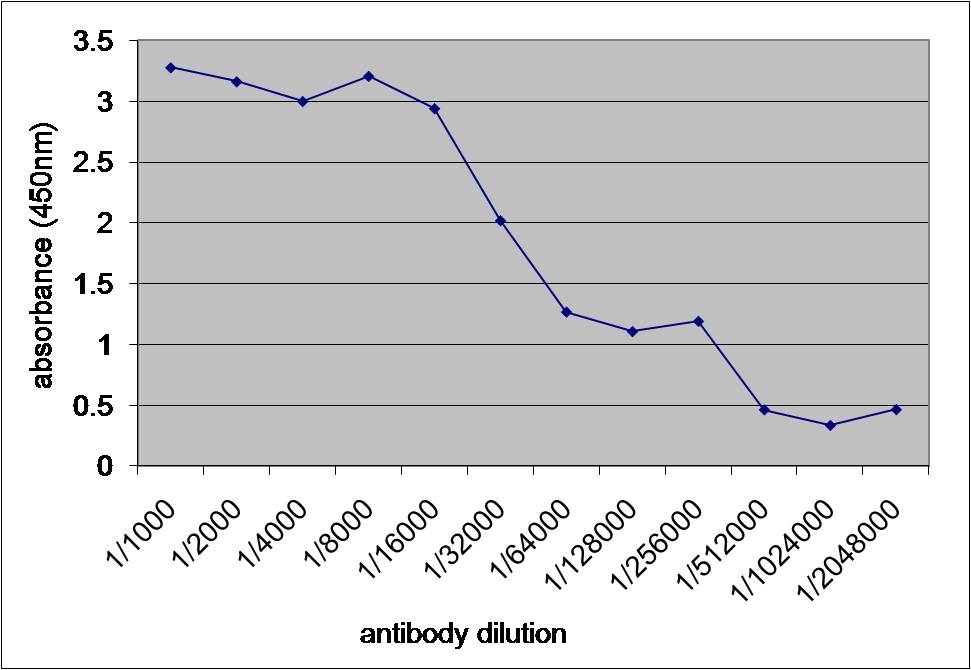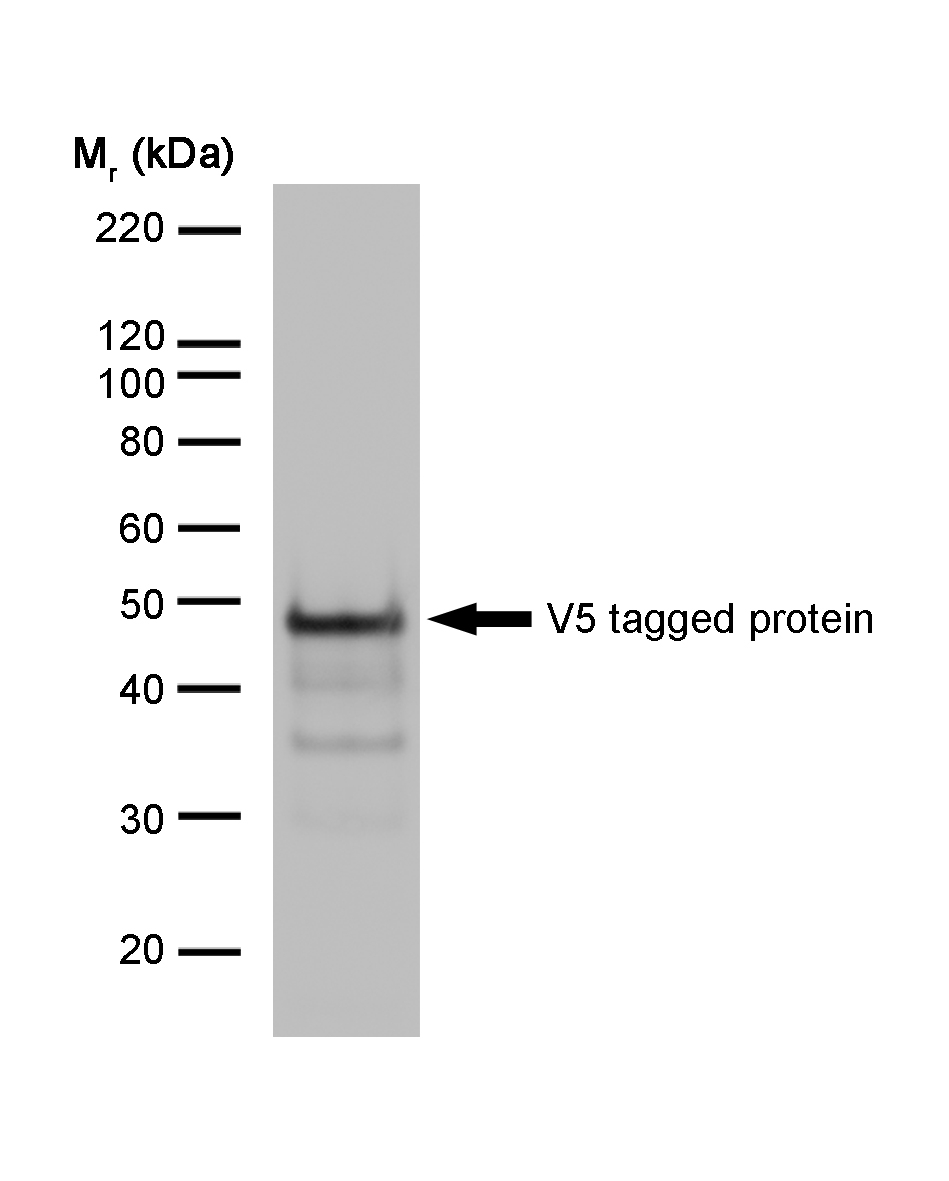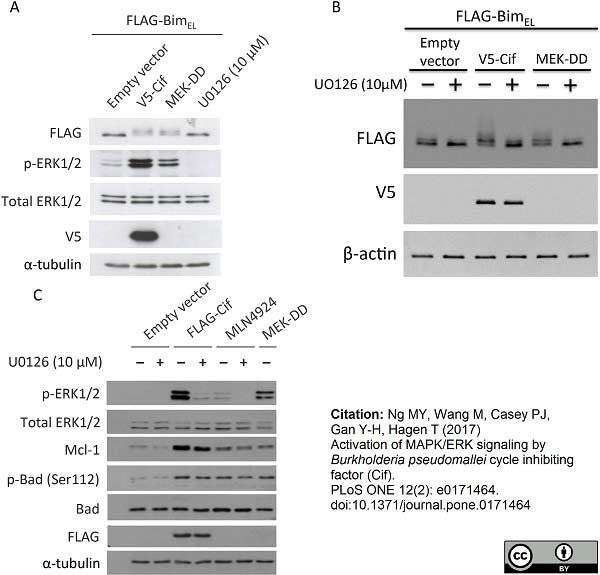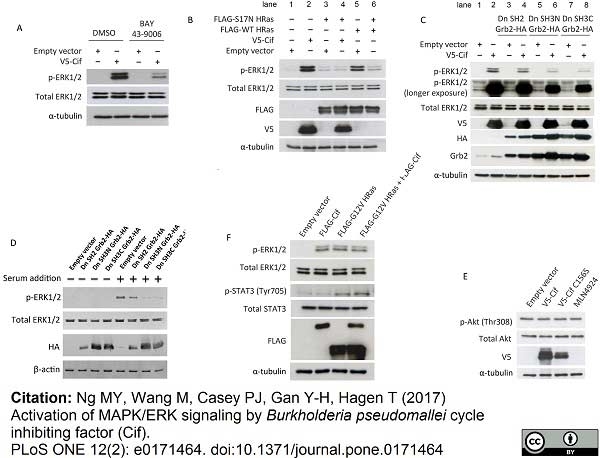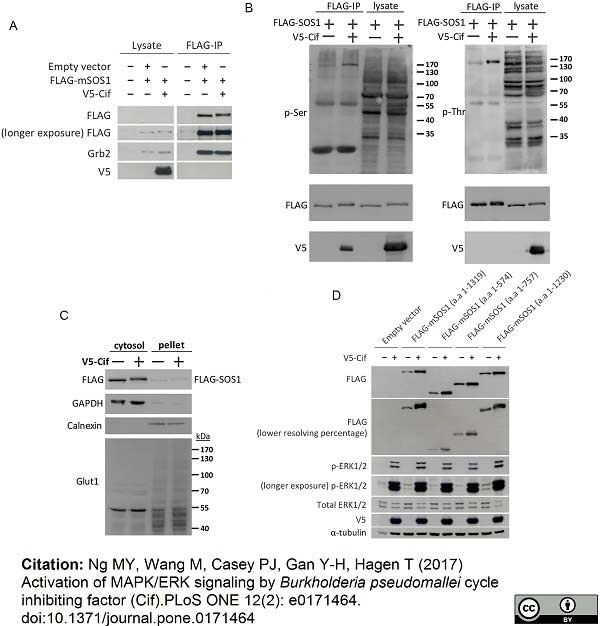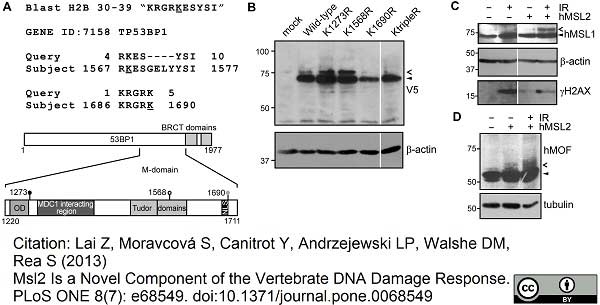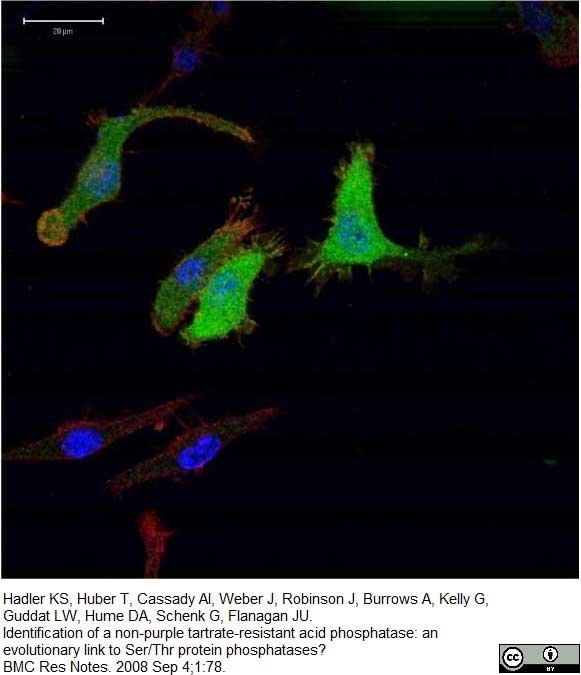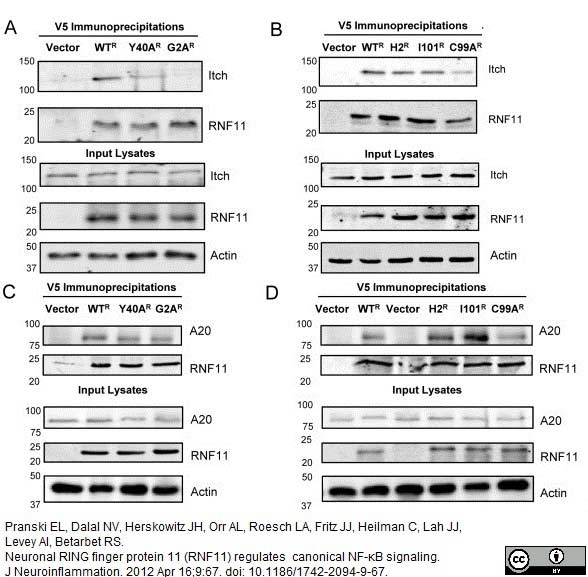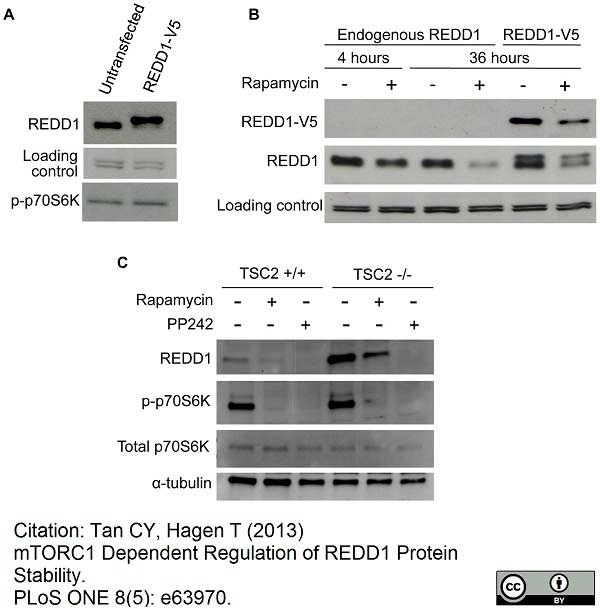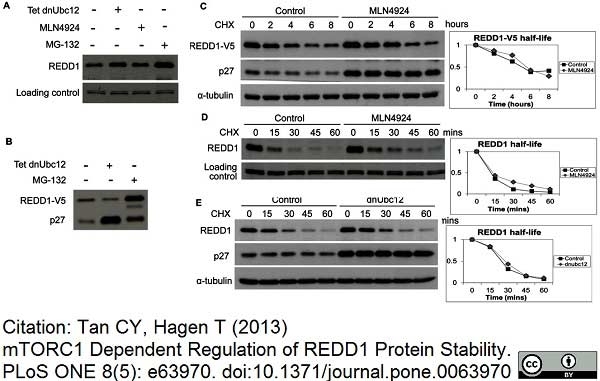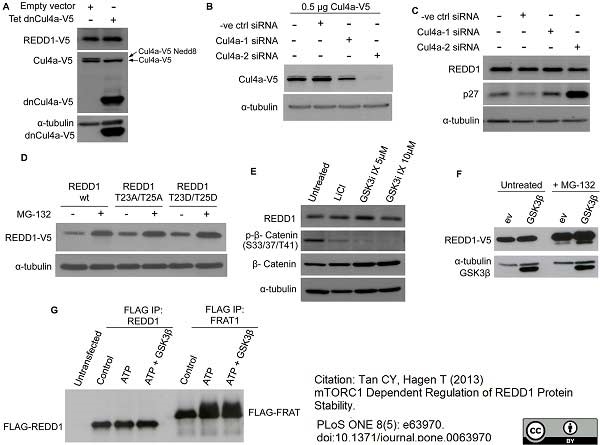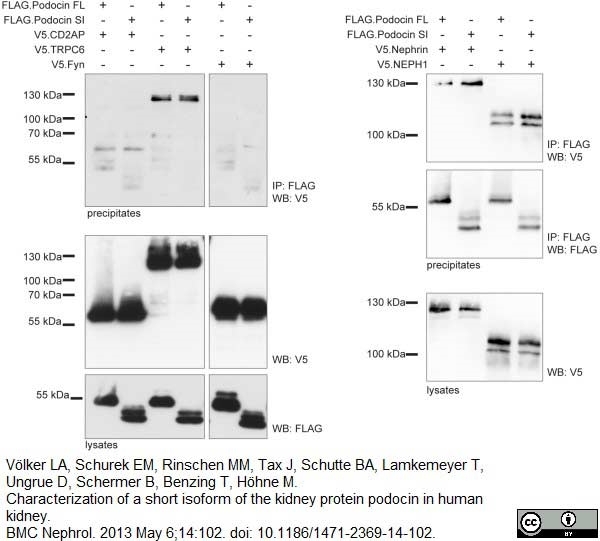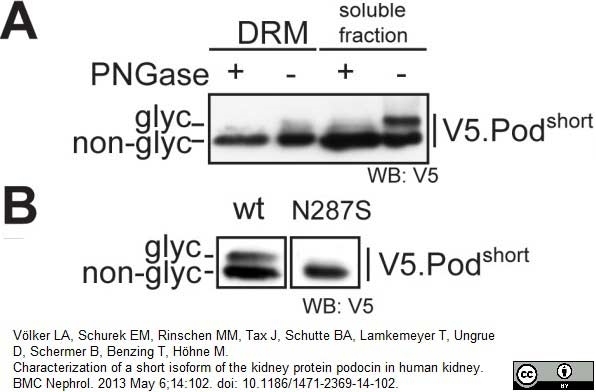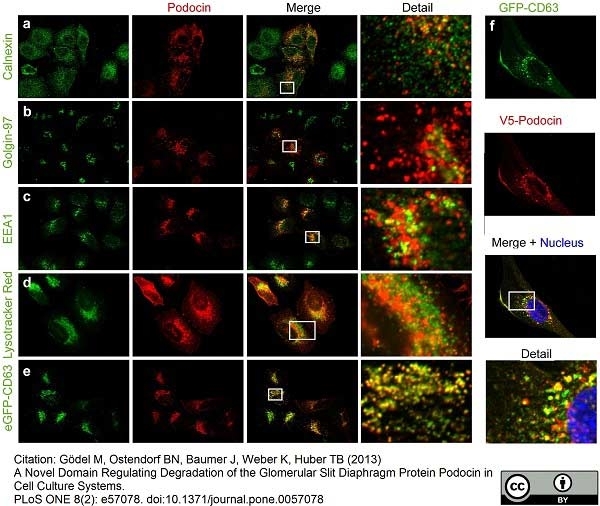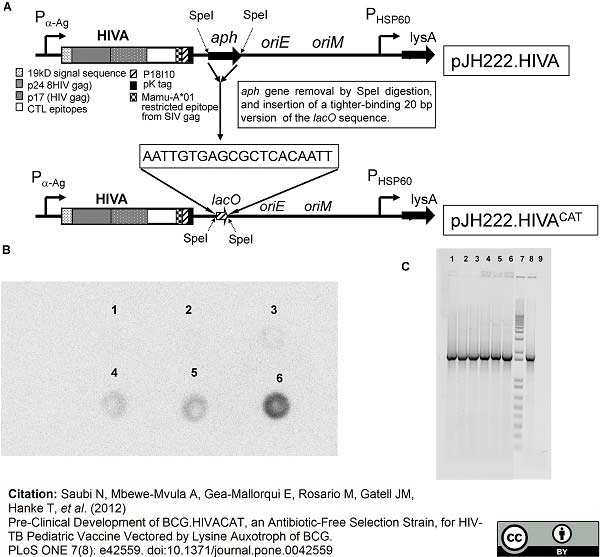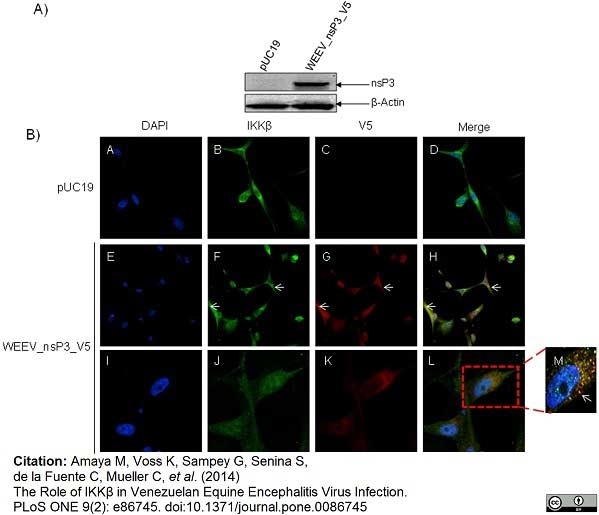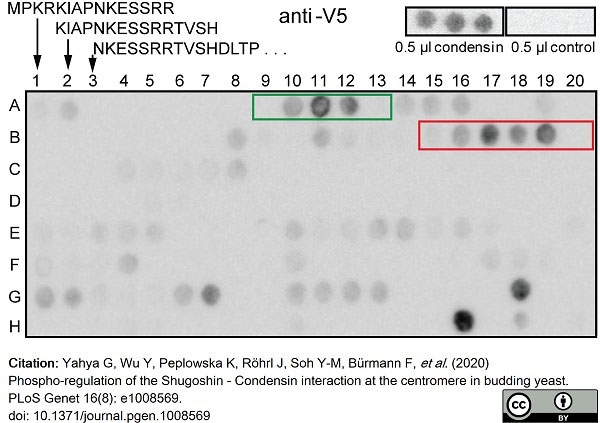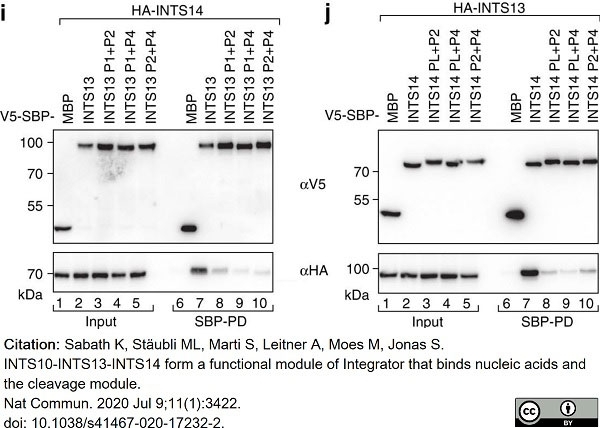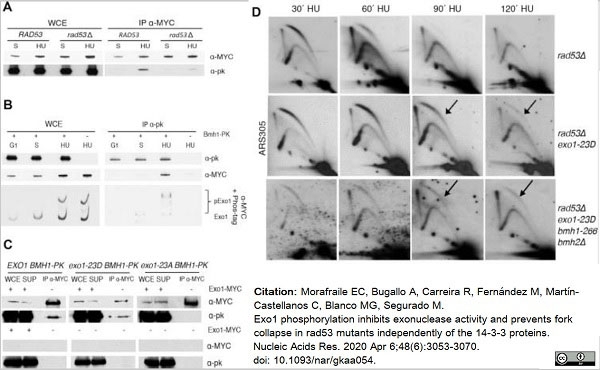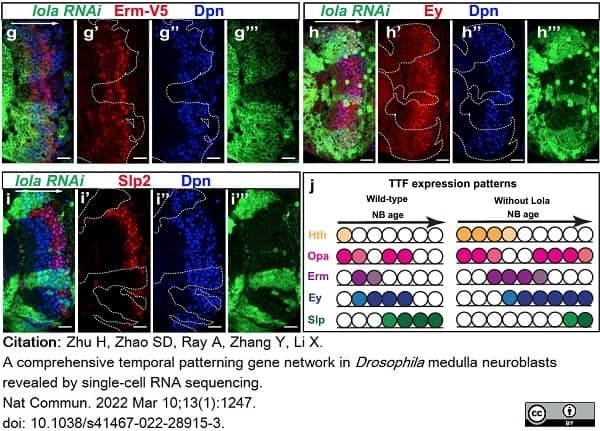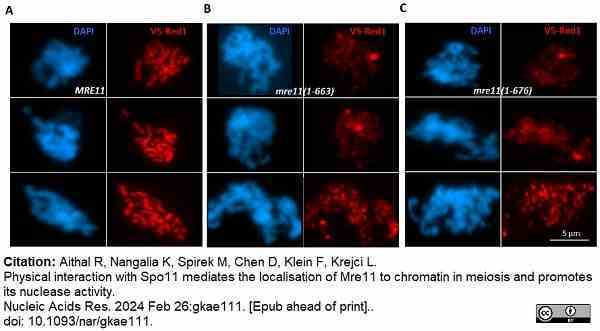V5-Tag antibody | SV5-Pk1



























Mouse anti V5-Tag:Biotin
- Product Type
- Monoclonal Antibody
- Clone
- SV5-Pk1
- Isotype
- IgG2a
- Specificity
- V5-Tag
| Mouse anti V5-Tag, clone SV5-Pk1 recognizes the sequence, IPNPLLGLD, present on the P/V proteins of the paramyxovirus, SV5 (Dunn et al.1999). Clone SV5-Pk1 is used to detect recombinant proteins, some of which include transmembrane and secreted proteins, that have labeled with tags containing this sequence (Randall et al.1993 and Zhao et al. 2005). |

Our V5-Tag (SV5-Pk1) Antibody has been referenced in >215 publications* *Based on June 2020 data from CiteAb's antibody search engine. |
- Target Species
- Viral
- Product Form
- Purified IgG conjugated to biotin - liquid
- Preparation
- Purified IgG prepared by affinity chromatography on Protein A from tissue culture supernatant
- Buffer Solution
- Phosphate buffered saline
- Preservative Stabilisers
- 0.09% sodium azide (NaN3)
- Immunogen
- Paramyxovirus Simian-Virus 5 (SV5)
- Approx. Protein Concentrations
- IgG concentration 1.0 mg/ml
- Fusion Partners
- Spleen cells from immunized BALB/c mice were fused with cells of the SP2/0 Ag14 myeloma cell line.
- Regulatory
- For research purposes only
- Guarantee
- 12 months from date of despatch
- Acknowledgements
- This product is manufactured under an exclusive license from the University of St. Andrews, UK.
Avoid repeated freezing and thawing as this may denature the antibody. Storage in frost-free freezers is not recommended.
| Application Name | Verified | Min Dilution | Max Dilution |
|---|---|---|---|
| ELISA | 1/250 | 1/2500 | |
| Immunohistology - Frozen | |||
| Western Blotting | 1/1000 | 1/5000 |
References for V5-Tag antibody
-
Southern, J.A. et al. (1991) Identification of an epitope on the P and V proteins of simian virus 5 that distinguishes between two isolates with different biological characteristics.
J Gen Virol. 72 ( Pt 7): 1551-7. -
Randall, R.E. et al. (1994) Purification of antibody-antigen complexes containing recombinant SIV proteins: comparison of antigen and antibody-antigen complexes for immune priming.
Vaccine. 12 (4): 351-8. -
Hirst, K. et al. (1994) The transcription factor, the Cdk, its cyclin and their regulator: directing the transcriptional response to a nutritional signal.
EMBO J. 13 (22): 5410-20. -
Rodriguez, M.S. et al. (1995) Inducible degradation of I kappa B alpha in vitro and in vivo requires the acidic C-terminal domain of the protein.
Mol Cell Biol. 15 (5): 2413-9. -
Jaffray, E. et al. (1995) Domain organization of I kappa B alpha and sites of interaction with NF-kappa B p65.
Mol Cell Biol. 15 (4): 2166-72. -
Hanke, T. et al. (1995) Attachment of an oligopeptide epitope to the C-terminus of recombinant SIV gp160 facilitates the construction of SMAA complexes while preserving CD4 binding.
J Virol Methods. 53 (1): 149-56. -
Dunn, C. et al. (1999) Fine mapping of the binding sites of monoclonal antibodies raised against the Pk tag.
J Immunol Methods. 224 (1-2): 141-50. -
Young, D.F. et al. (2001) Single amino acid substitution in the V protein of simian virus 5 differentiates its ability to block interferon signaling in human and murine cells.
J Virol. 75: 3363-70.
View The Latest Product References
-
Sanchez Garcia, J. et al. (2004) The C-terminal zinc finger of the catalytic subunit of DNA polymerase delta is responsible for direct interaction with the B-subunit.
Nucleic Acids Res. 32 (10): 3005-16. -
Zhao, C. et al. (2005) Human ISG15 conjugation targets both IFN-induced and constitutively expressed proteins functioning in diverse cellular pathways.
Proc Natl Acad Sci U S A. 102:10200-5 -
Hornemann, T. et al. (2006) Cloning and initial characterization of a new subunit for mammalian serine-palmitoyltransferase.
J Biol Chem. 281: 37275-81. -
Chew, E.H. and Hagen, T. (2007) Substrate-mediated regulation of cullin neddylation.
J Biol Chem. 282: 17032-40. -
Boggio, R. et al. (2007) Targeting SUMO E1 to ubiquitin ligases: a viral strategy to counteract sumoylation.
J Biol Chem. 282: 15376-82. -
Létourneau, S. et al. (2007) Design and pre-clinical evaluation of a universal HIV-1 vaccine.
PLoS One. 2: e984. -
Hadler, K.S. et al. (2008) Identification of a non-purple tartrate-resistant acid phosphatase: an evolutionary link to Ser/Thr protein phosphatases?
BMC Res Notes. 1: 78. -
Chung, J.S. et al. (2009) The DC-HIL/syndecan-4 pathway inhibits human allogeneic T-cell responses.
Eur J Immunol. 39: 965-74. -
Stauch, B. et al. (2009) Model structure of APOBEC3C reveals a binding pocket modulating ribonucleic acid interaction required for encapsidation.
Proc Natl Acad Sci U S A. 106: 12079-84. -
Shi, X. and Elliott, R.M. (2009) Generation and analysis of recombinant Bunyamwera orthobunyaviruses expressing V5 epitope-tagged L proteins.
J Gen Virol. 90: 297-306. -
Schmidt, C.K. et al. (2009) Conserved features of cohesin binding along fission yeast chromosomes.
Genome Biol. 10: R52. -
Milward, A. et al. (2010) Hepatitis C virus NS5A protein interacts with beta-catenin and stimulates its transcriptional activity in a phosphoinositide-3 kinase-dependent fashion.
J Gen Virol. 91: 373-81. -
Han, M.H. et al. (2010) Proteomics analysis reveals overlapping functions of clustered protocadherins.
Mol Cell Proteomics. 9: 71-83. -
Lou, J.J. et al. (2010) Inhibition of hypoxia-inducible factor-1alpha (HIF-1alpha) protein synthesis by DNA damage inducing agents.
PLoS One. 5: e10522. -
Björk, J.K. et al. (2010) miR-18, a member of Oncomir-1, targets heat shock transcription factor 2 in spermatogenesis.
Development. 137(19):3177-84. -
Liebau, M.C. et al. (2011) Nephrocystin-4 regulates Pyk2-induced tyrosine phosphorylation of Nephrocystin-1 to control targeting to monocilia.
J Biol Chem. 286: 14237-45. -
Gatherer, D. et al. (2011) High-resolution human cytomegalovirus transcriptome.
Proc Natl Acad Sci U S A.108: 19755-60. -
Gallazzini, M. et al. (2011) High NaCl-induced activation of CDK5 increases phosphorylation of the osmoprotective transcription factor TonEBP/OREBP at threonine 135, which contributes to its rapid nuclear localization.
Mol Biol Cell. 22: 703-14. -
Herskowitz, J.H. et al. (2011) Rho kinase II phosphorylation of the lipoprotein receptor LR11/SORLA alters amyloid-beta production.
J Biol Chem. 286 (8): 6117-27. -
Zhao, A. et al (2011) Rapid isolation of high-affinity human antibodies against the tumor vascular marker Endosialin/TEM1, using a paired yeast-display/secretory scFv library platform.
J Immunol Methods. 363: 221-32. -
Höhne, M. et al. (2011) The BAR domain protein PICK1 regulates cell recognition and morphogenesis by interacting with Neph proteins.
Mol Cell Biol. 31: 3241-51. -
Kasahara, K. et al. (2011) Hmo1 directs pre-initiation complex assembly to an appropriate site on its target gene promoters by masking a nucleosome-free region.
Nucleic Acids Res. 39: 4136-50. -
Patino, G.A. et al. (2011) Voltage-Gated Na+ Channel {beta}1B: A Secreted Cell Adhesion Molecule Involved in Human Epilepsy.
J Neurosci. 31: 14577-91. -
Brennan, B. et al. (2011) Generation and characterization of a recombinant Rift Valley fever virus expressing a V5 epitope-tagged RNA-dependent RNA polymerase.
J Gen Virol. 92 (Pt 12): 2906-13. -
Badrinath, S. et al. (2012) Position 156 influences the peptide repertoire and tapasin dependency of human leukocyte antigen B*44 allotypes.
Haematologica. 97: 98-106. -
Mahuzier, A. et al. (2012) Dishevelled stabilization by the ciliopathy protein Rpgrip1l is essential for planar cell polarity.
J Cell Biol. 198: 927-40. -
Orime, K. et al. (2013) Trefoil Factor 2 Promotes Cell Proliferation in Pancreatic β-Cells through CXCR-4-Mediated ERK1/2 Phosphorylation.
Endocrinology. 154: 54-64. -
Tan, C.Y. & Hagen, T. (2013) mTORC1 dependent regulation of REDD1 protein stability.
PLoS One. 8 (5): e63970. -
Singh, A. et al. (2014) Trypanosome MKT1 and the RNA-binding protein ZC3H11: interactions and potential roles in post-transcriptional regulatory networks.
Nucleic Acids Res. 42: 4652-68. -
Mui, M.Z. et al. (2015) The Human Adenovirus Type 5 E4orf4 Protein Targets Two Phosphatase Regulators of the Hippo Signaling Pathway.
J Virol. 89 (17): 8855-70. -
Malik, S. et al. (2015) Adrenocorticotropic Hormone (ACTH) Responses Require Actions of the Melanocortin-2 Receptor Accessory Protein on the Extracellular Surface of the Plasma Membrane.
J Biol Chem. 290 (46): 27972-85. -
Shi X et al. (2016) Bunyamwera orthobunyavirus glycoprotein precursor is processed by cellular signal peptidase and signal peptide peptidase.
Proc Natl Acad Sci U S A. 113 (31): 8825-30. -
Ng, M.Y. et al. (2017) Activation of MAPK/ERK signaling by Burkholderia pseudomallei cycle inhibiting factor (Cif).
PLoS One. 12 (2): e0171464. -
Voskarides, K. et al. (2017) A functional variant in NEPH3 gene confers high risk of renal failure in primary hematuric glomerulopathies. Evidence for predisposition to microalbuminuria in the general population.
PLoS One. 12 (3): e0174274. -
Carrocci, T.J. et al. (2017) SF3b1 mutations associated with myelodysplastic syndromes alter the fidelity of branchsite selection in yeast.
Nucleic Acids Res. 45 (8): 4837-52. -
Kerwin, S.K. et al. (2018) Regulated Alternative Splicing of Drosophila Dscam2 Is Necessary for Attaining the Appropriate Number of Photoreceptor Synapses.
Genetics. 208 (2): 717-728. -
Hassler, M. et al. (2019) Structural Basis of an Asymmetric Condensin ATPase Cycle.
Mol Cell. 74 (6): 1175-1188.e9. -
Játiva, S. et al. (2019) Cdc14 activation requires coordinated Cdk1-dependent phosphorylation of Net1 and PP2A-Cdc55 at anaphase onset.
Cell Mol Life Sci. 76 (18): 3601-20. -
Chung, C.S. et al. (2019) Dynamic protein-RNA interactions in mediating splicing catalysis.
Nucleic Acids Res. 47 (2): 899-910. -
Morafraile, E.C. et al. (2020) Exo1 phosphorylation inhibits exonuclease activity and prevents fork collapse in rad53 mutants independently of the 14-3-3 proteins.
Nucleic Acids Res. 48 (6): 3053-70. -
Sabath, K. et al. (2020) INTS10-INTS13-INTS14 form a functional module of Integrator that binds nucleic acids and the cleavage module.
Nat Commun. 11 (1): 3422. -
Lee, B.G. et al. (2020) Cryo-EM structures of holo condensin reveal a subunit flip-flop mechanism.
Nat Struct Mol Biol. 27 (8): 743-51. -
Yahya, G. et al. (2020) Phospho-regulation of the Shugoshin - Condensin interaction at the centromere in budding yeast.
PLoS Genet. 16 (8): e1008569. -
Waizenegger, A. et al. (2020) Mus81-Mms4 endonuclease is an Esc2-STUbL-Cullin8 mitotic substrate impacting on genome integrity.
Nat Commun. 11 (1): 5746. -
Bajak, K. et al. (2020) A potential role for a novel ZC3H5 complex in regulating mRNA translation in Trypanosoma brucei.
J Biol Chem. 295 (42): 14291-304. -
Du, Z. et al. (2021) Structure-function analysis of oncogenic EGFR Kinase Domain Duplication reveals insights into activation and a potential approach for therapeutic targeting.
Nat Commun. 12 (1): 1382. -
Ivanusic, D. et al. (2021) The large extracellular loop of CD63 interacts with gp41 of HIV-1 and is essential for establishing the virological synapse.
Sci Rep. 11 (1): 10011. -
Halova, L. et al. (2021) A TOR (target of rapamycin) and nutritional phosphoproteome of fission yeast reveals novel targets in networks conserved in humans.
Open Biol. 11 (4): 200405. -
Kovács, H.A. et al. (2021) Characterization of the Proprotein Convertase-Mediated Processing of Peroxidasin and Peroxidasin-like Protein
Antioxidants. 10 (10): 1565. -
Lucas, R.M. et al. (2021) SCIMP is a spatiotemporal transmembrane scaffold for Erk1/2 to direct pro-inflammatory signaling in TLR-activated macrophages.
Cell Rep. 36 (10): 109662. -
Kao, C.Y. et al. (2021) Evidence for complex dynamics during U2 snRNP selection of the intron branchpoint.
Nucleic Acids Res. 49 (17): 9965-97. -
Forey, R. et al. (2021) A Role for the Mre11-Rad50-Xrs2 Complex in Gene Expression and Chromosome Organization.
Mol Cell. 81 (1): 183-197.e6. -
Wang, Y.T. et al. (2022) K48/K63-linked polyubiquitination of ATG9A by TRAF6 E3 ligase regulates oxidative stress-induced autophagy.
Cell Rep. 38 (8): 110354. -
Bracci, N. et al. (2022) Rift Valley fever virus Gn V5-epitope tagged virus enables identification of UBR4 as a Gn interacting protein that facilitates Rift Valley fever virus production.
Virology. 567: 65-76. -
Zhu, H. et al. (2022) A comprehensive temporal patterning gene network in Drosophila. medulla neuroblasts revealed by single-cell RNA sequencing.
Nat Commun. 13 (1): 1247. -
Choudhary, R. et al. (2023) Sen1 and Rrm3 ensure permissive topological conditions for replication termination.
Cell Rep. 42 (7): 112747. -
Chung, C.S. et al. (2023) An ATP-independent role for Prp16 in promoting aberrant splicing.
Nucleic Acids Res. 51 (20): 10815-28. -
Heuzé, J. et al. (2023) RNase H2 degrades toxic RNA:DNA hybrids behind stalled forks to promote replication restart.
EMBO J. : e113104. -
McConnell, A. et al. (2023) Determinants of Developability and Evolvability of Synthetic Miniproteins as Ligand Scaffolds.
J Mol Biol. 435 (24): 168339. -
Litwin, I. et al. (2023) ISW1a modulates cohesin distribution in centromeric and pericentromeric regions.
Nucleic Acids Res. 51 (17): 9101-21. -
Sizemore, T.R. et al. (2023) Heterogeneous receptor expression underlies non-uniform peptidergic modulation of olfaction in Drosophila.
Nat Commun. 14 (1): 5280. -
Coombs, J.R. et al. (2024) NLRP12 interacts with NLRP3 to block the activation of the human NLRP3 inflammasome.
Sci Signal. 17 (820): eabg8145. -
Zhao, X. et al. (2024) Cellular targets and lysine selectivity of the HERC5 ISG15 ligase.
iScience. 27 (2): 108820. -
Aithal, R. et al. (2024) Physical interaction with Spo11 mediates the localisation of Mre11 to chromatin in meiosis and promotes its nuclease activity.
Nucleic Acids Res. 26 Feb gkae111 [Epub ahead of print].
- Synonyms
- PK-TAG
- RRID
- AB_324248
- UniProt
- P11207
- GO Terms
- GO:0003723 RNA binding
- GO:0046872 metal ion binding
- GO:0016070 RNA metabolic process
- GO:0030683 evasion by virus of host immune response
Please Note: All Products are "FOR RESEARCH PURPOSES ONLY"
View all Anti-Viral ProductsAlways be the first to know.
When we launch new products and resources to help you achieve more in the lab.
Yes, sign me up